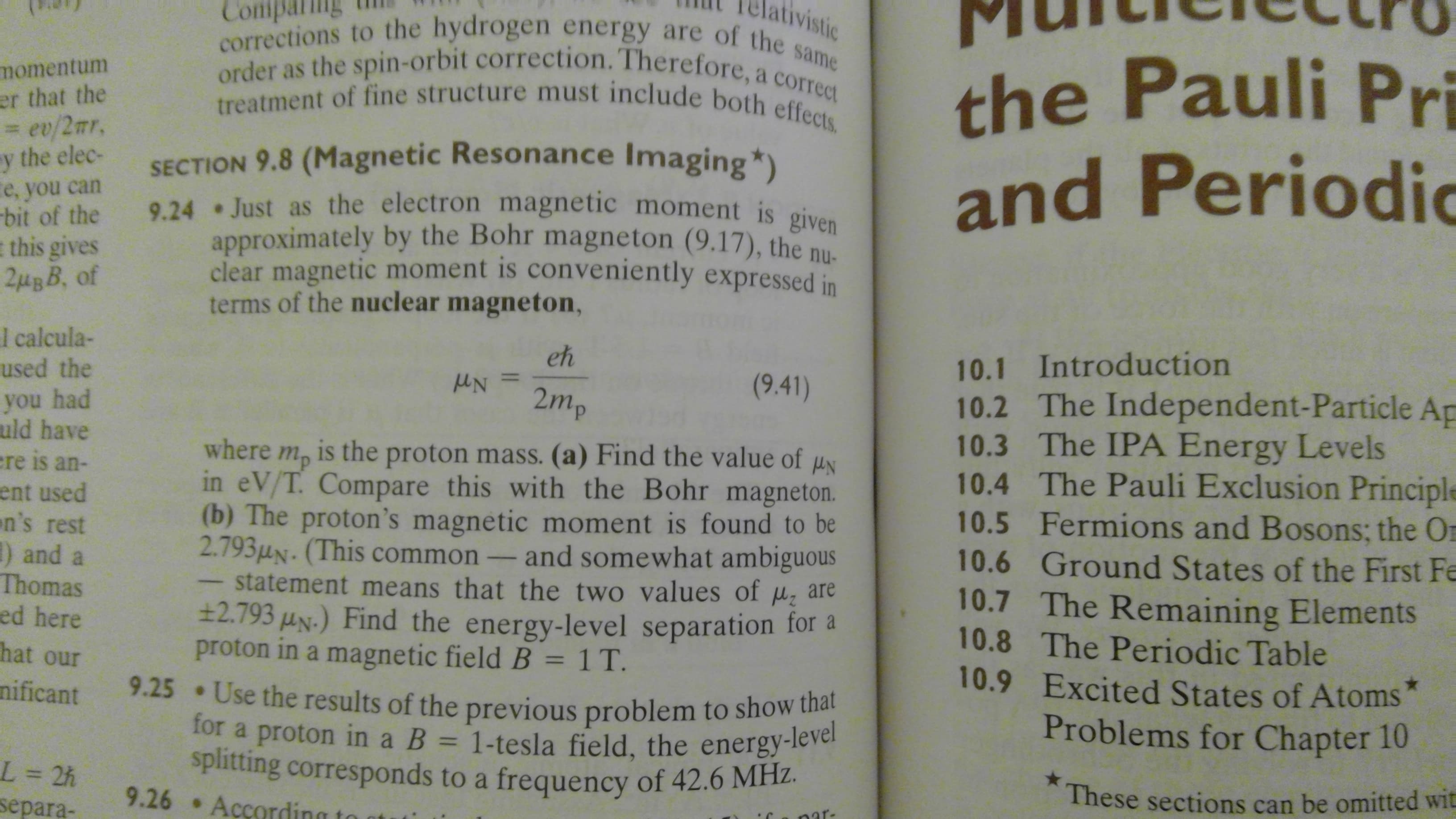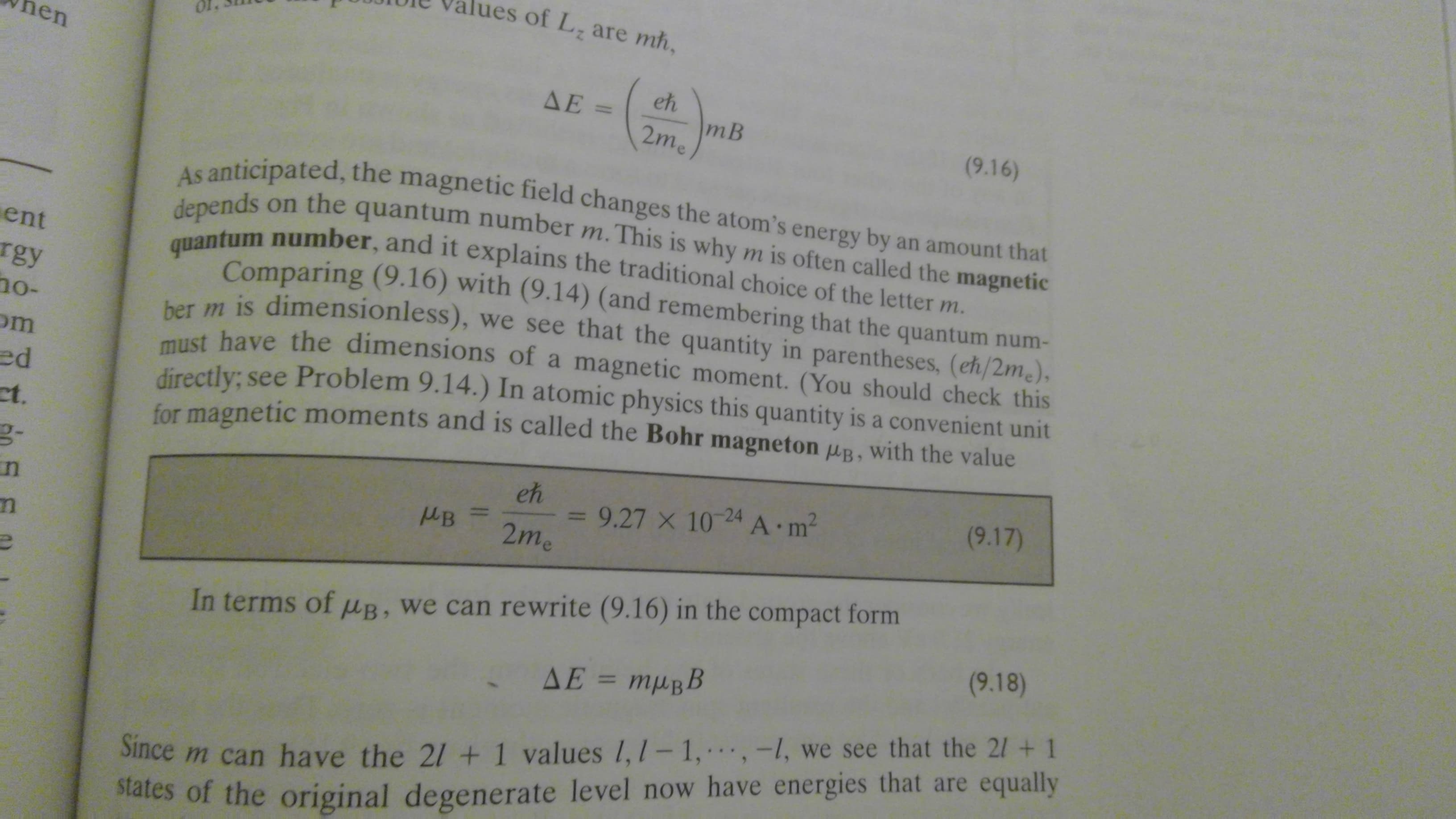tivistic corrections to the hydrogen energy are of the same treatment of fine structure must include both effects. order as the spin-orbit correction. Therefore, a correct the Pauli Pri and Periodic momentum er that the = ev/2mr, y the elec- SECTION 9.8 (Magnetic Resonance Imaging ") 9.24 Just as the electron magnetic moment is given approximately by the Bohr magneton (9.17), the ni clear magnetic moment is conveniently expressed in terms of the nuclear magneton, e, you can bit of the this gives l calcula- used the you had uld have eh 10.1 Introduction (9.41) 2mp 10.2 The Independent-Particle Ap 10.3 The IPA Energy Levels 10.4 The Pauli Exclusion Principle 10.5 Fermions and Bosons; the O 10.6 Ground States of the First Fe 10.7 The Remaining Elements 10.8 The Perio dic Table 10.9 Excited States of Atoms where is the proton mass. (a) Find the value of тр in eV/T. Compare this with the Bohr magneton. (b) The proton's magnetic moment is found to be 2.7934N. (This common statement means that the two values of ±2.793 uN.) Find the energy-level separation for proton in a magnetic field B 1 T. re is an- ent used n's rest ) and Thomas ed here and somewhat ambiguous are hat our 9.25 Use the results of the previous problem to show that nificant for a proton in a B = 1-tesla field, the energy-level spitting corresponds to a frequency of 42.6 MH2. 9.26 According Problems for Chapter 10 L = 2h separa- These sections can be omitted wit nar- es of L, are mh, en eh AE mB 2me (9.16) As anticipated, the magnetic field changes the atom's energy by an amount that on the quantum number m. This is why m is often called the magnetic depends quantum number, and it explains the traditional choice of the letter m. ent Comparing (9.16) with (9.14) (and remembering that the quantum ber m is dimensionless), we see that the quantity in parentheses, (eh/2me), must have the dimensions of a magnetic moment. (You should check this directly; see Problem 9.14.) In atomic physics this quantity is a convenient unit for magnetic moments and is called the Bohr rgy num- o- om ed ct with the value magneton PB eh (9.17) 9.27 X 10 24 A m2 2me , we can rewrite (9.16) in the compact form In terms of uB (9.18) AE = mpBB Since m can have the 21 + 1 values 1,1-1, .., -1, we see that the 2/ + 1 dies of the original degenerate level now have energies that are equally
tivistic corrections to the hydrogen energy are of the same treatment of fine structure must include both effects. order as the spin-orbit correction. Therefore, a correct the Pauli Pri and Periodic momentum er that the = ev/2mr, y the elec- SECTION 9.8 (Magnetic Resonance Imaging ") 9.24 Just as the electron magnetic moment is given approximately by the Bohr magneton (9.17), the ni clear magnetic moment is conveniently expressed in terms of the nuclear magneton, e, you can bit of the this gives l calcula- used the you had uld have eh 10.1 Introduction (9.41) 2mp 10.2 The Independent-Particle Ap 10.3 The IPA Energy Levels 10.4 The Pauli Exclusion Principle 10.5 Fermions and Bosons; the O 10.6 Ground States of the First Fe 10.7 The Remaining Elements 10.8 The Perio dic Table 10.9 Excited States of Atoms where is the proton mass. (a) Find the value of тр in eV/T. Compare this with the Bohr magneton. (b) The proton's magnetic moment is found to be 2.7934N. (This common statement means that the two values of ±2.793 uN.) Find the energy-level separation for proton in a magnetic field B 1 T. re is an- ent used n's rest ) and Thomas ed here and somewhat ambiguous are hat our 9.25 Use the results of the previous problem to show that nificant for a proton in a B = 1-tesla field, the energy-level spitting corresponds to a frequency of 42.6 MH2. 9.26 According Problems for Chapter 10 L = 2h separa- These sections can be omitted wit nar- es of L, are mh, en eh AE mB 2me (9.16) As anticipated, the magnetic field changes the atom's energy by an amount that on the quantum number m. This is why m is often called the magnetic depends quantum number, and it explains the traditional choice of the letter m. ent Comparing (9.16) with (9.14) (and remembering that the quantum ber m is dimensionless), we see that the quantity in parentheses, (eh/2me), must have the dimensions of a magnetic moment. (You should check this directly; see Problem 9.14.) In atomic physics this quantity is a convenient unit for magnetic moments and is called the Bohr rgy num- o- om ed ct with the value magneton PB eh (9.17) 9.27 X 10 24 A m2 2me , we can rewrite (9.16) in the compact form In terms of uB (9.18) AE = mpBB Since m can have the 21 + 1 values 1,1-1, .., -1, we see that the 2/ + 1 dies of the original degenerate level now have energies that are equally
Related questions
Question
How do I solve for parts A & B for 9.24? The name of the chapter is electron spin, and this chapter resides in

Transcribed Image Text:tivistic
corrections to the hydrogen energy are of the same
treatment of fine structure must include both effects.
order as the spin-orbit correction. Therefore, a correct
the Pauli Pri
and Periodic
momentum
er that the
= ev/2mr,
y the elec-
SECTION 9.8 (Magnetic Resonance Imaging ")
9.24 Just as the electron magnetic moment is given
approximately by the Bohr magneton (9.17), the ni
clear magnetic moment is conveniently expressed in
terms of the nuclear magneton,
e, you can
bit of the
this gives
l calcula-
used the
you had
uld have
eh
10.1 Introduction
(9.41)
2mp
10.2 The Independent-Particle Ap
10.3 The IPA Energy Levels
10.4 The Pauli Exclusion Principle
10.5 Fermions and Bosons; the O
10.6 Ground States of the First Fe
10.7 The Remaining Elements
10.8 The Perio dic Table
10.9 Excited States of Atoms
where
is the proton mass. (a) Find the value of
тр
in eV/T. Compare this with the Bohr magneton.
(b) The proton's magnetic moment is found to be
2.7934N. (This common
statement means that the two values of
±2.793 uN.) Find the energy-level separation for
proton in a magnetic field B 1 T.
re is an-
ent used
n's rest
) and
Thomas
ed here
and somewhat ambiguous
are
hat our
9.25 Use the results of the previous problem to show that
nificant
for a proton in a B = 1-tesla field, the energy-level
spitting corresponds to a frequency of 42.6 MH2.
9.26 According
Problems for Chapter 10
L = 2h
separa-
These sections can be omitted wit
nar-

Transcribed Image Text:es of L, are mh,
en
eh
AE
mB
2me
(9.16)
As anticipated, the magnetic field changes the atom's energy by an amount that
on the quantum number m. This is why m is often called the magnetic
depends
quantum number, and it explains the traditional choice of the letter m.
ent
Comparing (9.16) with (9.14) (and remembering that the quantum
ber m is dimensionless), we see that the quantity in parentheses, (eh/2me),
must have the dimensions of a magnetic moment. (You should check this
directly; see Problem 9.14.) In atomic physics this quantity is a convenient unit
for magnetic moments and is called the Bohr
rgy
num-
o-
om
ed
ct
with the value
magneton PB
eh
(9.17)
9.27 X 10 24 A m2
2me
, we can rewrite (9.16) in the compact form
In terms of uB
(9.18)
AE = mpBB
Since m can have the 21 + 1 values 1,1-1, .., -1, we see that the 2/ + 1
dies of the original degenerate level now have energies that are equally
Expert Solution
This question has been solved!
Explore an expertly crafted, step-by-step solution for a thorough understanding of key concepts.
Step by step
Solved in 4 steps with 3 images
